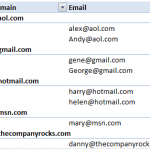In my experience, a high percentage of Excel users run into problems when working with Dates – and Times! In fact, I estimate that, during the past two weeks, I received 25 questions from viewers – they were asking for my help when working with Dates in their Excel workbooks.
Here, in this tutorial, I gathered together the most common problems that my viewers asked me help them to solve.. Gaining a firm understanding of how Excel Stores and Formats Dates is an Essential Skill that you must master!
Dates Stored as Serial Number
Dates are stored as a serial number in Excel. For example, if you type the number 1 into a blank cell and then change the formatting to a Short Date, you will see 1/1/1900 displayed. This is the date on which Excel began to keep track of time. Dates that are entered correctly align to the right side of the cell.
Concepts Covered in this Tutorial
- Use the =TODAY() Function – this date will automatically update.
- Use the Keyboard Shortcut Ctrl + ; (semi-colon) to “Date Stamp” a cell – this is a static date.
- Change the Formatting of a Date to e”General” – this reveals the actual serial number that Excel stores for the Date.
- Apply Custom Date Codes to format cells that contain Dates.
- Learn why it is essential that you always enter years using four digit codes – to avoid “the Century Break.”
- Learn how to clear all formatting from cells before pasting or entering data. in them
- Use the Text-to-Columns Wizard to convert “unfriendly” Date Text Labels to “usable” Numeric Date Values .
- Tips for copying and pasting a range of cells formatted as USA Short Dates to a customized “European” Date Format.
Visit My Secure Online Shopping Website
I invite you to stop by my secure online shopping website – http://shop.thecompanyrocks.com – to take a look at all of th many training resources that I offer to you.
Watch Video in High Definition
Follow this link to watch my Excel Tutorial in High Definition on my YouTube Channel – DannyRocksExcels




